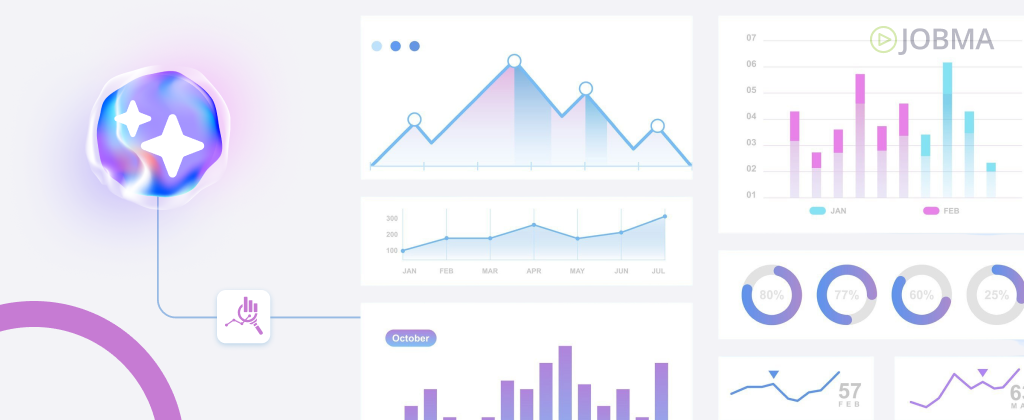How AI is Transforming Performance Management for HR Success
Performance Management is the continuous process of setting expectations, supporting growth, and aligning individual contributions with the company’s goals. It’s a labor-intensive process. It calls for clear goals, consistent feedback, and meaningful conversations. All of that must be tracked and revisited across weeks, months, and shifting priorities. For many teams, it’s hard to keep pace. Reviews get delayed, feedback loses context, and development plans fall through. The process is as critical as it is complex.
AI is beginning to change that. Automating manual tasks, like review scheduling, feedback collection, data entry, and appraisal formatting, removing operational drag. It also delivers real-time insights, reducing subjectivity in evaluation by focusing on measurable patterns. With this tool, organizations can manage performance more efficiently and continuously, with sharper focus and less friction.
Across HR, AI is driving a broader transformation, from hiring and development to workforce planning. In performance management, specifically, it involves making once-static processes like annual reviews, generic development plans, and uniform goal setting into dynamic systems that adapt in real-time. With AI, these processes can become personalized, data-informed, and more actionable.

It’s not just a few early adopters, it’s a part of a larger global shift. According to Fortune Business Insights, the global artificial intelligence market is projected to grow from USD 294.16 billion in 2025 to USD 1,771.62 billion by 2032, with a CAGR of 29.2%.
What Are the Key Applications of AI in Performance Management?
Performance management touches every stage of the employee experience and integrating AI into the process keeps it structured, responsive, and insight-driven. Here are the key ways organizations are using AI to strengthen how they support, develop, and evaluate talent.
It Starts Before Day One: The foundation of performance management is laid well before the employee’s first day, during the hiring process. Just as law firms rely on structured case management systems to track and manage client workflows, HR departments can benefit from organized, centralized tools. Cloud technology has made remote hiring seamless. Reliable cloud hosting plays a major role in ensuring smooth interview experiences for recruiters worldwide, especially when organizations aim to connect with Ottawa IT consulting experts for technical hiring or infrastructure support. This stage offers insights into how a candidate thinks, communicates, and solves problems. When captured in a structured way and integrated into a centralized performance management system, the information becomes the starting point of a more connected employee journey. It becomes easy to track whether initial promise leads to long-term results. It also sets the stage for smarter onboarding, informed coaching, and internal mobility.
Continuous Performance Monitoring: Usually traditional performance review happens once or twice a year. AI helps move fast by continuously tracking and analyzing various data points related to employee performance, from project timelines to communication activity. AI Solutions helps move fast by continuously tracking and analyzing various data points related to employee performance, from project timelines to communication activity. It can aggregate data from multiple sources to provide a more holistic and unbiased picture of an employee’s performance. Enhance your HR website’s visibility with AI SEO Automation from SEOWEBSTER, which uses advanced analytics to optimize content and improve search rankings, ensuring your performance management insights reach a broader audience. This allows for real-time insights and paints a picture of how an employee is performing rather than relying solely on annual or semi-annual reviews. You can find additional tips and professional insights from various SEO professionals in the SEO Power Plays newsletter.
Skill Gap Analysis, Spot Gaps & Identify Strengths: As much as performance management is about identifying skill gaps, it’s also about identifying strengths and potential. It can identify strengths, weaknesses, and areas for improvement, and even suggest concrete steps and training resources. AI automates the tedious administrative tasks of data collection, analysis, and report generation. This frees up managers and HR professionals to focus on more strategic initiatives and meaningful conversations. Betterworks found that using AI-powered feedback summaries helped reduce review time by 50%-75%. That’s time HRs and managers can use to focus on the actual people.
Personalized Development Plan: Every employee learns differently and at their own pace. And one of AI’s greatest strengths is its ability to personalize at scale. It can quickly track skill patterns across individuals, teams, or organizational levels, and recommend personalized growth plans – from suggesting relevant training courses and upskilling, to career trajectories that align with the employee’s and the organization’s goals. Similar to how a product recommendations engine personalizes shopping experiences, AI can tailor app development and professional development paths to each individual’s needs.
For instance, a software engineer showing strength in backend development but lacking cloud infrastructure skills might receive tailored recommendations like an AWS certification course, mentorship from a DevOps specialist, and project assignments that build relevant experience. Over time, these insights can help shape a path toward roles such as a full-stack developer or engineering team lead. To make the most of this personalization, knowing how to use AI agents effectively ensures that recommendations are delivered at the right time, tracked properly, and continuously refined based on real-world outcomes.
This makes development planning more strategic, actionable, and tailored, replacing the one-size-fits-all approach with a clear, data-backed path for growth.
Smarter Goal Settings & KPI: Setting goals isn’t straightforward – it varies from role, and industry, to individual preferences. Organizations looking to maximize these AI capabilities often benefit from working with specialized generative ai consulting services to develop tailored implementation strategies that align with their unique performance management requirements. Generative AI can assist in tailoring goals and Key Performance Indicators (KPIs) to an individual’s role, industries, and past performance, making them more actionable and relevant. It can also track progress and keep everyone aligned along the way.
Forecasting What’s Next: Using historical trends and behavioral data, conversational AI solutions can flag employees who may be at risk of leaving, spot upcoming performance dips, predict trends, and even forecast talent shortages or hiring needs. This kind of accurate forecast allows HR to address potential issues and make informed decisions. It turns the HR department into a proactive business partner, not just a reactive support function.
Reduce Bias & Ensure Fairness: Bias tends to creep into human evaluation all the time. It shows up in subtle ways – who gets credit, who gets feedback, and who is seen as leadership material. While AI can’t eliminate it, it can create guardrails. Analyzing data across periods, reviewers, and teams, it can flag inconsistencies that suggest recency bias, favoritism, or subjective evaluation patterns. It provides HR with the tools to course-correct and ensure performance is being measured against standards, not impressions. It’s not bias-proof as it depends on the data it’s been trained on, but it offers a more consistent foundation.
Streamline Performance Review Cycle: AI can manage the cadence of review processes, prompting feedback collection, sending reminders, organizing input, and even generating first-draft summaries based on available data. With Profit.co performance review system, managers can further streamline this process by leveraging automated reminders and structured feedback templates to maintain consistency and save time. Instead of spending hours writing reviews from scratch, managers can start with a well-structured outline and customize it as needed. This workflow automation saves time, improves consistency, and reduces reviewer fatigue, especially in large organizations.
Better Employee Self-Evaluation Support: Self-evaluation is beneficial for introspection, but often lacks objectivity, is time-consuming, and does not provide a comprehensive view. AI changes that, by helping employees pull data from across tools – emails, projects, messages, and compile a snapshot of their contribution. LLM Development Services can further streamline this process by summarizing vast amounts of employee data into clear, unbiased self-evaluations. This results in a richer and more grounded self-evaluation, it helps employees advocate for their work, it boosts confidence, and encourages ownership.

Why the Adoption of AI Matters in Performance Management
The impact of AI in performance management goes beyond efficiency, it’s about creating a system that actually works. By integrating AI-powered tools, organizations can analyze employee data, uncover hidden patterns, and provide actionable insights that support better decision-making and continuous growth.
For HR, it means less time spent chasing feedback or combing through data, and more time spent solving bigger people’s challenges. For managers, it means performance reviews that are consistent and data-informed. And for employees, it means receiving timely feedback, clearer expectations, and growth conversations.

Here’s what it looks like in practice:
Improved Accuracy and Objectivity: Reduces human errors and biases with data-driven insights. Betterworks, for instance, uses AI to highlight feedback trends and calibrate performance ratings across teams.
Better Efficiency: Repetitive admin tasks can take hours and AI can automate that process. 85% of employers who utilize automation or AI report time savings and increased efficiency (SHRM).
Continuous Improvement: Tools like Lattice and 15Five AI supports continuous feedback, so employees know where they stand. The result is a culture where small wins are celebrated, course corrections happen in real time, and development doesn’t feel out of reach.
Informed Decision-Making: Whether it’s making decisions related to promotion, raises, or allocating resources, AI provides deeper insight backed by patterns and progress metrics.
Greater Employee Engagement: Platforms like Culture Amp link performance data with engagement surveys, allowing teams to act quickly on sentiment and build cultures where people stay and grow.
Current Adoption & Outlook
Today, 72% of HR jobs departments are already using AI in performance management (Eightfold.ai Talent Survey). The urgency is growing with 76% of HR leaders saying they risk falling behind if they don’t adopt generative AI in the next 12 to 24 months (Gartner).
That said, there’s still skepticism around it, especially from employees. While AI use at work has doubled in the past two years, only 37% of U.S. employees feel comfortable with it being part of their performance review (Qualtrics, 2024).
This gap highlights a key challenge, even the best tools need a human rollout plan. There is a need for clear communication, ethical use, and transparency to define successful adoption.
What to Watch Out For: Responsible Implementation
Using AI in performance management has incredible potential, but it needs to be implemented as responsible AI with human oversight. Companies planning to invest in AI for HR need to look beyond the excitement of automation.Here are some things to keep in mind:
Data Privacy & Security: Organizations must have robust policies and procedures in place to protect sensitive data and ensure that they do not become a liability.
Algorithmic Bias: While AI aims to reduce human bias, it can perpetuate bias if the data it’s trained on is biased, so make sure to use clean data. Regular audits, transparent inputs, and diverse training sets are critical to ensure fairness.
AI Hallucination & Inaccuracy: AI tools can flag trends, recommend training, or predict outcomes, but they can sometimes generate inaccurate output. So, human verification remains critical.
Over-Reliance: AI is most effective when it supports human decision-making. It should act as a compass, helping teams navigate complex performance dynamics with clarity. But the actual coaching, feedback, and growth plans should remain rooted in human connection.
The Bottom Line
AI can turn performance management into a more dynamic, fair, and future-ready process. It’s helping companies rethink performance as not a once or twice-a-year formality but as an ongoing, insight-driven conversation. With the right tools in place, it’s easier to recognize achievements, guide development, and build teams that thrive.
But success doesn’t depend on technology alone – it requires thoughtful implementation, a clear goal, and continued human oversight. When all those pieces are in place and used responsibly, AI becomes a powerful ally to build stronger, smarter, and more engaged teams.




